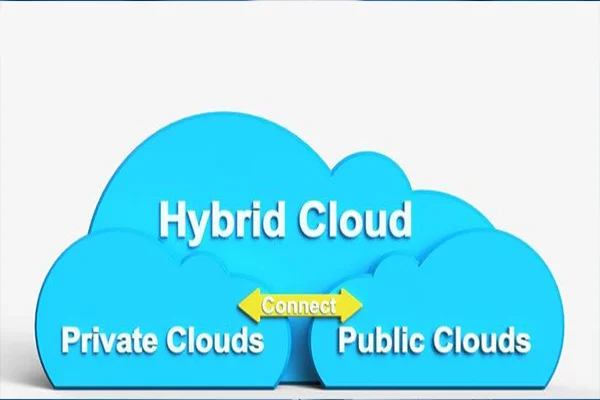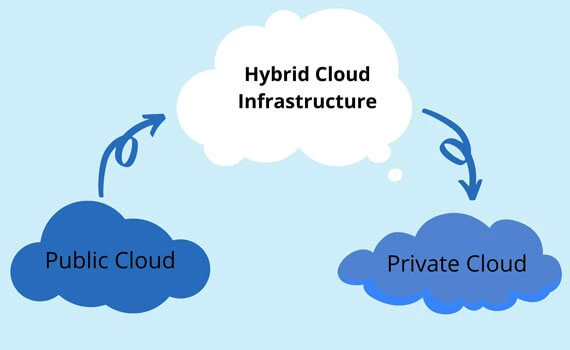What is a hybrid cloud?
- Home
- Blog Details

- November 29 2021
- admin
Cloud computing, or the on-demand availability of computer system resources, has recently taken the world by storm, with cloud providers like AL iCloud, AWS, IBM, Google, Microsoft Azure, and Oracle creating Software-as-a-Service, Marketing-as-a-Service, Analytics-as-a-Service, and now Infrastructure-as-a-Service, amongst others, to capture the seemingly insatiable customer demand for services. Whether a business should go with a private cloud, a public cloud, an omni cloud, or a hybrid cloud aren’t quickly answered without understanding a company’s current set-up and its potential future IT demands.
The hybrid cloud creates a single IT infrastructure that runs its applications, systems, and workloads. It joins a company’s on-premises private cloud services with a third-party, public cloud, which gives an organization the ability to select optimal cloud providers for each application, container, or workload and move freely between the two clouds as circumstances and situations change. Some popular third-party vendors like AWS, IBM, Microsoft, Alibaba, and Google, provide their cloud services over the public Internet.

Unavailable to the public, private clouds are hosted on-premises and provide businesses with many benefits of a public cloud, i.e., self-service usage, scalability, elasticity, and robust security measures. The fundamental difference between a private and a public cloud is the level of responsibility needed to run them. The IT department of the company hosting the private cloud takes care of all the private cloud’s staffing, cost, accountability, and maintenance expenses.
Public clouds, however, are provided over the Internet by a third-party vendor, who charges by consumption, either by CPU, storage, bandwidth, software usage, or a combination of them. Public clouds numb down the cost and hassle of buying, operating, and maintaining on-prem hardware infrastructure and application. The cloud service provider supports and manages the system. Deployment is fast on a public cloud, scalability is almost infinite, the cost is easily controlled, and the system can be highly secure.
The hybrid cloud lets an organization choose between multiple cloud providers depending on which company specializes in a particular area. For example, an organization looking for a robust AI platform might go for Google Cloud because Tensor Flow is a powerful Google AI tool that would seamlessly add to Google’s cloud offerings. Companies looking to utilize Excel, Word, Visual Basic, or Microsoft Teams might choose Azure because it’s owned by Microsoft and would probably be the most cost-effective option. Because every implementation is unique and so many variables go into building a cloud solution, organizations should shop around and piece together their solution keeping in mind the advantages and disadvantages of each cloud provider.

Traditional hybrid cloud architecture used to come as unsophisticated pre-packaged options, but today’s hybrid cloud architecture is highly focused on supporting the portability of workloads across all cloud environments. Containers and microservice architecture are simplifying the deployment of workloads across multiple cloud options. This approach utilizes a single application composed of many loosely coupled, independently deployable, and reusable more minor services. These applications are being deployed in lightweight containers, including executable units containing both the application code and the virtualized operating system dependencies needed to run everything.
Today, the line between public and private clouds is blurring. Public clouds are now going private, and private clouds are going public, but a coalescence is coming. Many cloud vendors now offer on-premises public cloud services that run on a customer’s site. Private clouds can now be found at off-premises data centers, virtual private clouds (VPCs), virtual private networks (VPNs), or even rented from third-party providers. At the same time, a container orchestration platform automates application deployment across multiple cloud establishments.
The hybrid cloud has many benefits. At a time when the work-from-home revolution is growing, hybrid clouds can help support a remote workforce. Organizations can reduce IT costs as well as improve scalability, increase collaboration, and enhance innovation. Hybrid clouds provide better business continuity while increasing agility. Counter-intuitively hybrid clouds can improve security and risk management. When jumping into the cloud, an organization is partnering with companies whose very existence is threatened if their security fails. For companies looking to take the next step in their digital transformation, a look to the hybrid cloud is in order.

